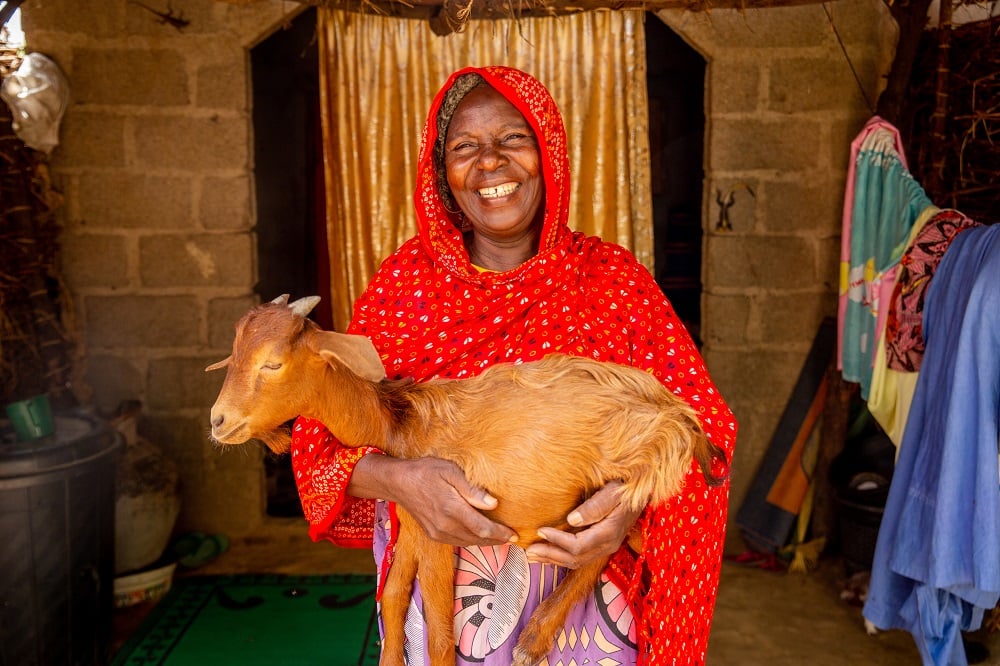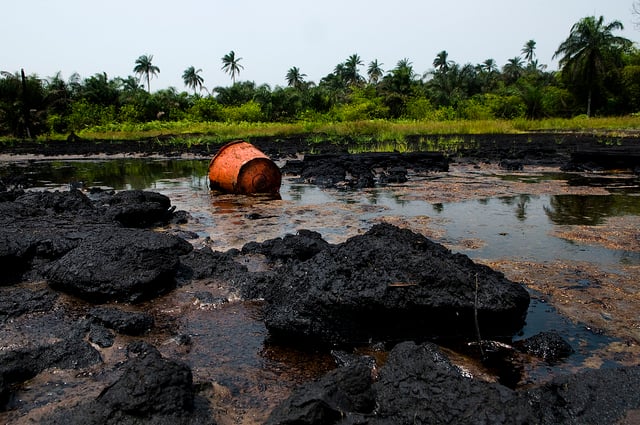Zara Bulama is a mother of 8 children who fled from the conflict in Monguno. She lost her husband to the conflict and walked 3-4 days till she got to her relative's house in Gongulong. She and her family have lived with the relative ever since. She had no means of livelihood and depended only on her relative. In September 2020, FAO gave her four goats to care for as livestocks. "I am very happy I now have something to do that could yield something for me to." The FAO supports activities focused on providing technical assistance and policy advice for the development of crops, livestock, fisheries and forestry sub sectors, with due emphasis given to institutional capacity building and development of local skills and expertise to ensure sustainability in camps and local communities in states across NigeriaPhoto: UNOCHA/Damilola Onafuwa
BY ADEDEJI ADEMIGBUJI AND CHRISTINE COOL
Insecurity and conflict have plagued northeast Nigeria for almost 12 years, causing millions of people to feel the pain of hunger. As the northeast enters the lean season, food security assessments released in March 2021 indicated that looming food insecurity threatens an estimated 4.4 million people, 775,000 of whom are at extreme risk. COVID-19 has only exacerbated the situation, causing economic shocks that have affected families’ ability to access or purchase food.
This dire humanitarian crisis is exacerbated by access constraints and other challenges that hinder the principled, timely and much-needed delivery of humanitarian aid. In one of the latest security incidents, in April 2021, food warehouses in Damasak and the humanitarian office were burned to the ground by non-State armed groups (NSAGs). This led to a temporary reduction in operations, which heightened the already alarming risk of severe food insecurity.
Without urgent action, thousands of families will descend into catastrophic food conditions during this lean season.
The UN and its humanitarian partners are working around the clock to ensure that families have enough food to survive.
Advertisement
The familiar pain of hunger: Amina’s story
Amina Adamo, 25, is only too familiar with hunger; she has lived without food for days and with only very small rations for months at a time. Inside her makeshift shelter at the Elmiskin internally displaced persons (IDP) camp in Jere, near Maiduguri, Borno State, she is one of the many people affected by food insecurity.
Amina fears hunger. She relied on food assistance for almost five years, up until it was cut off three months ago. The only food assistance available in the camp was meant for pregnant and breastfeeding mothers.
IDPs like Amina count on humanitarian assistance as their only lifeline. The ongoing conflict and rising attacks on humanitarians delivering aid to communities like hers have made life more difficult and hindered the provisions sent to families who need them most.
Advertisement
Despite enormous risks to their safety, the UN and its partners continue to find ways to deliver aid and food assistance through a process called “localization.” Localization allows partners and agencies to work with local non-governmental organizations (NGOs) to deliver humanitarian aid and assistance to unreached communities constantly under threat of violence from armed groups. This process allows for local solutions to local problems.
To provide food to communities, the World Food Programme (WFP) works through partners such as Intersos and local NGOs like Salient Humanitarian. And the Nigeria Humanitarian Fund focuses on supporting local partners, ensuring they receive humanitarian financing to meet needs at the community level.
Five years ago, Amina and her husband fled Bama, a garrison town near the Cameroon border, following an attack by non-State armed groups (NSAGs). The groups’ violent campaign has pushed approximately 8.7 million people from their homes in various communities in Borno, Adamawa and Yobe – the states most affected by conflict in the region.
Amina recounts the night they fled from their home
“We were sleeping when we started hearing gunshots. That was when we ran out of town. We walked for about six hours. We later got a vehicle to drop us at Bama in a parking lot. We started begging for money the next day in order to pay the driver,” she said.
Advertisement
Many families in the camp relied on farming to feed themselves, going out into open fields to plant crops to harvest. But the NSAGs’ rising attacks against farmers have created fear, forcing people to choose between planting food and preserving their own safety. This has only increased food insecurity in many conflict-affected communities.
“We are making caps and engaging in small trade. This is what we are doing in order to make it through the day.”
Life was good back home: Aisha’s story
There are few countries where planting food to eat would pose a threat to life. But this is a brutal reality in north-east Nigeria.
Aisha Idri, a mother of three, was living a good life in Baga, a fishing community near Lake Chad, before armed men attacked her village in 2015. She lost four siblings the night the attackers came, and she was forced to abandon her livestock and the family’s thriving fishing business.
Advertisement
Aisha now lives in one of the biggest IDP camps in Borno, where she receives food assistance from WFP.
“I am grateful that WFP supported me with food throughout my pregnancy. To ensure we have enough, we skip meals so what we are given lasts us longer,” she said.
Advertisement
The irony of all this is that Aisha’s family used to provide food to their neighbours, via their fishing business. But because of the conflict, they now wait expectantly to receive food each month, like many other families.
Daily survival is dangerous: Zara’s story
Rearing livestock is another dangerous activity in northeast Nigeria. Accessing farmland and fetching grass from the bush to feed animals may seem like mundane tasks. But in this context, herders literally risk their lives.
Advertisement
In the northeast, only garrison towns are secure, as farmers are allowed to farm only within a certain radius, designated as a “safe zone.” Anything outside this zone is no longer considered secure.
Life choices have come down to this: stay hungry longer and stay alive, or attempt to plant, grow or raise your own food and risk death.
Advertisement
This is the cost of the conflict. It is not only the visible bullets that kill people, and the traumatizing violence that affects communities’ survival. It is the unseen threat of hunger, one that you cannot touch or see but that can be just as deadly.
It is hard to fight against bullets and weapons when you are unarmed. But hunger, though invisible, is one threat that we can collectively respond to and push back.
Zara Bulama lost her husband to the protracted conflict in Monguno, another garrison town. She travelled for about four days to locate her relative in Gongulong, a town near Maiduguri.
When IDPs are forced to flee for safety, they often travel to host communities that often are already underresourced and barely getting by. The influx of new families exacerbates the already stretched supplies of food, shelter and water, overwhelming the host communities and creating a source of tension between residents and newcomers.
While living in the host community, Zara was able to survive on the support provided by the Food and Agriculture Organization (FAO) and WFP, which gave her new hope.
She explained: “I was a livestock farmer back home in Monguno before the conflict started. I was very happy when FAO gave me some goats to build my livestock business.
“FAO also provided feed for my goats. WFP also gave me some cash to feed my family so that I wouldn’t end up selling all my goats prematurely. We’re grateful to them.”
As the conflict in the northeast approaches its twelfth year, with no signs of slowing, people’s needs continue to increase amid the backdrop of rising attacks on humanitarians and assets. Security and access to affected communities are crucial to ensure the principled delivery of humanitarian aid. There is no humanitarian solution to what is happening to millions of people in northeast Nigeria; peace is the only solution.
Amina, Aisha and Zara continue to hold on to the promise of peace.
How you can help
This year, an estimated 8.7 million people in northeast Nigeria need some form of humanitarian assistance, 6.4 million of whom are targeted to receive aid as part of the UN and partners’ Humanitarian Response Plan. However, as of June 17, 2021 the plan is less than 20 percent funded. People like Amina, Aisha and Zara need your support. Together, we can help them feed their families.
Adedeji and Christine are public information officers at the United Nations Office for the Coordination of Humanitarian Affairs, Nigeria.
1 comments







This is a very touching and a sad reality for the poor in the northeast of Nigeria. All stakeholders must consciously take due actions